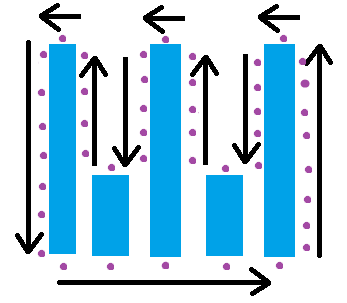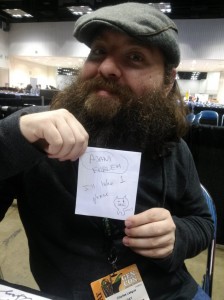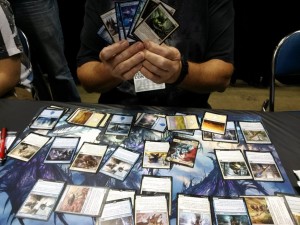At GenCon 2014 in Indianapolis, Indiana I had the pleasure of Head Judging a 66 person Sealed M15 Grand Melee GenCon Championship Qualifier event on August 16, 2014. For those of you who don’t know what Grand Melee is, it is one big Regular REL multiplayer game played at once.
If you want more information, see Comprehensive Rules 807.
CR 807 Grand Melee Variant807.2. Any multiplayer options used are decided before play begins. The Grand Melee variant uses the following default options.
- 807.2a. Each player has a range of influence of 1 (see rule 801).
- 807.2b. The attack left option is used (see rule 803).
- 807.2c. The attack multiple players and deploy creatures options aren’t used in the Grand Melee variant.
807.3. The players are seated at random.
807.4. The Grand Melee variant allows multiple players to take turns at the same time. Moving turn markers keep track of which players are currently taking turns. Each turn marker represents an active player’s turn.
- 807.4a. There is one turn marker for each full four players in the game.
- Example: A Grand Melee game with sixteen players has four turn markers. A game with fifteen players has three turn markers.
- 807.4b. The starting player in the game gets the first turn marker. The player four seats to that player’s left (the fifth player) takes the second turn marker, and so on until all the turn markers have been handed out. Each turn marker is assigned a number in this way. Then all players with turn markers start their turns at the same time.
- 807.4c. After a player ends his or her turn, that player passes the turn marker to the player on his or her left. If a player with a turn marker leaves the game during his or her turn, the player to his or her left takes the turn marker after that turn ends. If a player with a turn marker leaves the game before his or her turn begins, the player to his or her left takes the turn marker immediately.
- 807.4d. A player who receives a turn marker can’t begin his or her turn if any player in the three seats to his or her left has a turn marker. If this is the case, that player waits until the player four seats to his or her left takes the other turn marker.
- 807.4e. If a player leaves the game and that player leaving the game would reduce the number of turn markers in the game, the turn marker immediately to the departed player’s right is designated for removal. If more than one player leaves the game simultaneously, those players leaving the game would reduce the number of turn markers in the game, and there are multiple turn markers that could be removed, the marker with the lowest number is designated for removal. A turn marker may be designated for removal multiple times.
- 807.4f. For the purposes of determining if one or more players leaving the game would reduce the number of turn markers in the game (see rule 807.4e), disregard turn markers already designated for removal.
- 807.4g. If a player who’s taking a turn has a turn marker that’s been designated for removal, that turn marker is removed rather than being passed after that turn ends. If a player who’s not taking a turn has a turn marker that’s been designated for removal, that turn marker is removed immediately. If a removed turn marker had been designated for removal multiple times, the turn marker to its right becomes designated for removal that many times minus one.
- 807.4h. If one or more consecutively seated players leave the game, the players that were on either side of those seats don’t enter one another’s range of influence until the next turn begins.
- 807.4i If an effect causes a player with a turn marker to take an extra turn after the current one, that player keeps the turn marker and starts his or her next turn after the current turn ends, unless another turn marker is too close on either side at that time. If a turn marker is within three seats on the player’s left, the extra turn waits to begin until the player four seats to his or her left takes the other turn marker. If a turn marker is within three seats on the player’s right, the player passes the turn marker to his or her left when the turn ends rather than keeping it, and the player will take the extra turn immediately before his or her next turn.
- 807.4j. If an effect would cause a player to take an extra turn after the current turn, but that player wouldn’t have a turn marker at the start of that turn, that player will take the extra turn immediately before his or her next turn instead.
- Example: During Alex’s turn, he casts Time Walk, which causes him to take an extra turn after this one. During the same turn, the player to Alex’s left leaves the game, which causes the number of turn markers to be reduced. After Alex’s current turn ends, his turn marker is removed. He won’t take the extra turn from Time Walk until just before his normal turn the next time he receives a turn marker.
807.5. Rather than having a single stack, Grand Melee games contain multiple stacks. Each turn marker represents its own stack.
- 807.5a. A player gets priority for a particular turn marker’s stack only if the turn marker is within his or her range of influence or an object on that stack is controlled by a player within his or her range of influence.
- 807.5b. If a player has priority for multiple stacks and casts a spell, activates an ability, or a triggered ability he or she controls triggers, the player must specify which one of those stacks the spell or ability is put on. If an object on one of those stacks caused the triggered ability to trigger, the player must put it on that stack. If a resolving spell or ability on one of those stacks causes a player to cast a spell or create a copy of a spell, the new spell must be put on the same stack. If a spell or ability targets an object on one of those stacks, it must be put on the same stack as its target; it can’t target objects on multiple stacks.
Click here to close
I had two judges working this event with me, Kevin Tinsley and Sam Robinson
. They were fantastic and I’m glad they pushed through the night to help make it a great event!
Preparing the Tables and Player Meeting
We first originally had the idea to snake the players in between the two tables. Because of how the room was set up and considering the fact we couldn’t block the aisles running up and down the convention hall, we had to put tables in between tables. At first we were going to snake, but we realized that would have been complicated and I suggested doing it in a W shape, so we ended up starting in the top left hand side of the W with a couple tables set up like this:

The players got seated at their appropriate seats at 10:40 PM and I started my announcements at 10:45 PM. At the end of the announcements a player thanked us for judging their event and gave all 3 of us a round of applause. I then gave 40 minutes for the players to build their sealed deck. The build started at 10:52 PM and ended at 11:32 PM.
Let the Game Begin!
The event then started at 11:37 PM. I was in store for a long night.
Early in the night there was a call that had to do with Feast on the Fallen. It was Player A’s turn and Player B, who was to Player A’s right, had a Feast of the Fallen. Player B wanted to know if Player C, who is on Player B’s left, will cause Feast on the Fallen’s ability to trigger. It was ruled that yes, Player C can cause the ability to trigger because it is in the range of influence of Feast on the Fallen’s controller (CR 801.11).
Around 12:05 AM, people started getting eliminated more quickly. After the first hour, we were down to 49 players. And we had condensed to have players closer to their opponents.
Somewhere around 12:30 AM, after we had started removing turn counters, a player complained about how a player a few from his left had had more than one turn before he got one. I explained to him that we were following the Comprehensive Rules and that I did announce in the player meeting that this event may happen and not to get frustrated because that is the nature of the format and that he would get a turn soon and we were doing the best we could to keep the game as fair and fun as possible.
At 1:08 AM, we were down the 39 players. The time it is taking for people to be eliminated out of the game is slowing down significantly.
Around 1:12 AM, a player called me over and told me that he was really enjoying the event and thought I was running it well. Confidence booster!
When we were at 29 players, we counted players again and realized we actually were at 25 players and somehow had miscounted when players had been eliminated. I can assume this happened when more than one player was eliminated at once and I only marked that one was eliminated. We pulled another turn marker and everything was fixed and play continued.
1:43 AM – We had an issue where we had the wrong turn counter removed. Instead of pulling the turn marker to the right, the turn marker to the left of the eliminated player got removed. A player argued that that wasn’t the right one to be removed and I became involved. The player who had the turn counter that was supposed to be removed hadn’t started his turn yet because he overheard the conversation going on so I explained that we would replace the one that was wrongfully taken and we took the appropriate one because nothing significant happened and doing so would be following the correct rules (CR 807.4e).
 At 2:40 AM we are down to 19 people. I give an “alive, awake, alert, enthusiastic” pep talk to the players and congratulate them for making it that far in the tournament. I believe this helped keep the mood up as I got a lot of “wooo!”s from the players.
At 2:40 AM we are down to 19 people. I give an “alive, awake, alert, enthusiastic” pep talk to the players and congratulate them for making it that far in the tournament. I believe this helped keep the mood up as I got a lot of “wooo!”s from the players.
The eliminations are going really slow at this point, as expected, and we are at 17 players at 3:28 AM.
3:45 AM, everyone is starting to feel the effects of being tired. We had a player accidently grab the turn marker across the table and take a turn, skipping the player at the end of the table. It came to my attention and I backed up the player’s turn by putting the card he discarded at the end of turn back to his hand and put a card randomly from his hand to the top of his library. Then I gave the turn marker back to the appropriate player and told everyone to try to play carefully.
Ten minutes later we had another turn counter issue. After we condensed down the players, none of us noticed that a turn marker was at the end of the table. When counting players and turn markers I noticed one was missing. We talked to the players in that area and we figured out where the turn marker was supposed to be and appropriately placed it and play continued.
4:36 AM – Just something fun to note: a player milled himself out with no cards in his graveyard or in exile. He had all of his permanents on the board and a few spells in hand. It was an achievement.

At 5:05 AM we only had 7 players left! Only one more turn marker!
Somewhere around 6:00 AM everyone was really tired so we had an entertaining joke session with Liz Richardson. “What is red and bad for your teeth?” “A brick!”
Finally we have 4 players left at 6:04 AM! In top 4, we had another situation come up. Player A had been attacking with a double-strike lifelinking creature throughout the game and his opponent had been blocking with a 1/1 soldier token. Player A had been gaining life as though it does damage twice, when it only does damage once. I told player A that it would only gain life for the first strike damage and to be more aware when playing.
Another situation in the top 4 was that it was player A’s turn, A has a Feast on the Fallen trigger go off during his upkeep and player B responds by targeting C’s Phyrexian Revoker with Lightning Strike. Player C wanted to know if he could respond to player B’s spell even though the turn counter was out of his range of influence. The correct ruling here is yes, he is allowed to do respond because of CR 807.5a, “A player gets priority for a particular turn marker’s stack only if the turn marker is within his or her range of influence or an object on that stack is controlled by a player within his or her range of influence”.
The event finally ends at 7:22 AM. It was a long night, and I believe the players had a great time.
A few things to note if you ever decide to judge a Grand Melee event:
- Keep track of how many players and how many turn markers you have. Don’t just assume you have the right number.
- Announce that because of how removing turn markers works, some people might get 2 turns before another player gets a turn. It’s just how the format works.
- Remember to go over how range of influence works, and know how to explain it to players.

